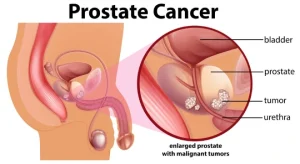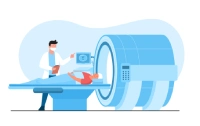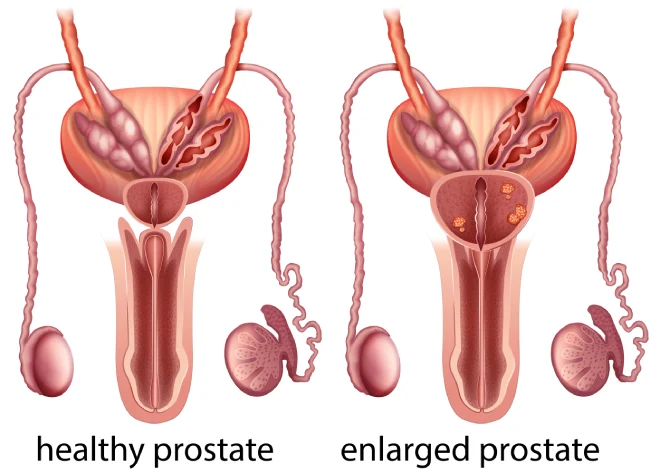Welcome to our comprehensive guide on stage 1 prostate cancer. Let’s explore the importance of early detection, the symptoms of stage 1 prostate cancer, how it is diagnosed, and the available treatment options
Understanding Stage 1 Prostate Cancer
Prostate cancer is a significant health concern for men worldwide. It is the most common cancer among men in India and the second most common cancer globally.
The prostate gland, a small walnut-shaped organ below the bladder, plays a crucial role in the reproductive system.
When prostate cancer is detected at an early stage, such as stage 1, it is still localised within the prostate gland and has not spread to other areas of the body.
This is a critical distinction as it often indicates a more favourable prognosis and increased treatment success rates.
Symptoms of Stage 1 Prostate Cancer
One of the challenges in detecting stage 1 prostate cancer is that it often does not cause noticeable symptoms. However, some men may experience subtle signs that can be attributed to other conditions. These symptoms include:

- Frequent urination, especially at night.
- Difficulty starting or stopping urination.
- Weak urine flow or interrupted stream.
- Blood in the urine or semen.
- Erectile dysfunction or pain during ejaculation.
- Discomfort or pain in the pelvic area.
It is important to note that these symptoms can also indicate non-cancerous conditions, such as benign prostatic hyperplasia (BPH). Therefore, consulting with a surgeon for an accurate diagnosis is essential.
Diagnosing Stage 1 Prostate Cancer
Early detection is critical in effectively managing stage 1 prostate cancer. Regular screenings play a crucial role in identifying the presence of cancer.

The primary screening methods are the prostate-specific antigen (PSA) test and the digital rectal exam (DRE).
The PSA test measures the levels of a protein called prostate-specific antigen in the blood. Elevated PSA levels can indicate the presence of prostate cancer, although it is not definitive proof.
A surgeon will interpret the PSA test results with other factors, such as age, family history, and overall health.
The DRE is a physical examination in which a doctor inserts a gloved, lubricated finger into the rectum to feel the size, shape, and texture. Abnormalities, such as hard or lumpy areas, can warrant further investigation.
It is important to remember that neither the PSA test nor the DRE provides a definitive diagnosis of prostate cancer.
If abnormalities are found during these screenings, additional tests, such as a biopsy, may be recommended to confirm the presence of cancer.
Also Read: Causes of Prostate Problems
Can Stage 1 Prostate Cancer Be Cured?
The good news is that stage 1 prostate cancer has a generally favourable prognosis. With early detection and appropriate treatment, the chances of successful treatment and potential cure are high. However, each case is unique and individualised treatment plans are essential.
Treatment Options for Stage 1 Prostate Cancer
Treatment options for stage 1 prostate cancer depend on various factors, including the aggressiveness of the cancer, the patient’s age, overall health, and personal preferences. Some standard treatment options include:
-
Active Surveillance:
This approach involves monitoring cancer’s progression through regular check-ups, PSA tests, and DREs. Treatment is delayed until there is evidence of disease progression.
-
Surgery:

A prostatectomy is a surgical procedure to remove the prostate gland. This can be done using traditional open surgery or minimally invasive techniques like laparoscopic or robotic-assisted surgery.
-
Radiation Therapy:

This treatment uses high-energy radiation to destroy cancer cells. External beam radiation therapy and brachytherapy (internal radiation) are two common approaches to treating stage 1 prostate cancer.
-
Cryotherapy:

Cryotherapy involves freezing the cancer cells, causing them to die. It is a less common treatment option for stage 1 prostate cancer but may be suitable for select cases.
Each treatment option carries potential side effects and risks that should be thoroughly discussed with your surgeon before deciding.
These side effects may include urinary incontinence, erectile dysfunction, bowel dysfunction, and hormonal changes.
Also Read: Radiologist’s Role in Variations of Prostate Cancer Detection
Survival Rates for Stage 1 Prostate Cancer
Stage 1 prostate cancer has a generally high survival rate due to its localised nature. According to the American Cancer Society, localised prostate cancer’s five-year relative survival rate is nearly 100%.
It is important to note that survival rates can vary based on individual factors and the specific characteristics of the cancer.
Regular follow-up and monitoring are crucial even after successful stage 1 prostate cancer treatment to ensure any potential recurrence or new developments are caught early.
Conclusion
Stage 1 prostate cancer is critical in the disease’s progression, as it offers the best chances for successful treatment and potential cure.
Men must be proactive about their health by recognising the signs and symptoms, undergoing regular screenings, and discussing any concerns with their surgeon.
Remember, early detection is critical. If you experience any symptoms or have risk factors for prostate cancer, do not hesitate to reach out to your doctor. They will guide you through the appropriate screenings and diagnostic tests to determine if further action is required.
While navigating stage 1 prostate cancer may seem daunting, various treatment options can help manage and potentially cure the disease.
Take the time to educate yourself about these options, discuss them with your surgeon, and make informed decisions that align with your individual needs and goals.
Lastly, don’t underestimate the power of a supportive network. Reach out to loved ones, join support groups, and connect with organisations that provide resources and assistance for those affected by prostate cancer. Remember, you are not alone in this journey.

